Every year, Americans add 70 pounds of clutter per person. Yet, only 1 in 5 homes use home organizing solutions to fight the mess. Clutter not only makes things messy but also steals time and causes stress.
Efficient home organization turns spaces into useful areas. This guide shows you how to declutter better, from kitchen drawers to living rooms. You’ll learn how to rethink storage and habits to save time, reduce stress, and make more room for what’s important.
Key Takeaways
- Clutter costs the average person 2.5 hours weekly searching for misplaced items.
- Effective home organizing solutions reduce stress and boost daily productivity.
- Smart storage systems create functional spaces without sacrificing style.
- Simple routines keep clutter from returning long-term.
- Cost-effective efficient home organization methods exist for every budget.
Understanding the Psychology Behind Clutter
Clutter isn’t just a mess; it’s a mental battle. Clutter-free home solutions are more than cleaning up. They tackle habits and emotions. Knowing why clutter forms helps you fight it better.
How Clutter Affects Mental Wellbeing
A 2020 UCLA study showed clutter raises cortisol levels, linking it to anxiety. Clutter makes it hard to focus and increases stress.
“Disorderly environments lead to disorderly minds,” noted researchers in the Journal of Environmental Psychology.
Visual chaos can make you tired and affect your sleep and decisions.
Why We Accumulate Things
There are three main reasons we keep things:
| Factor | Influence |
|---|---|
| Emotional Attachments | Items hold memories, making letting go feel like losing part of ourselves. |
| Consumer Culture | Marketing tactics push constant consumption, creating excess. |
| Fear of Scarcity | Belief that “I might need this later” fuels hoarding. |
The Benefits of a Decluttered Space
Clearing clutter frees up mental and emotional space. Benefits include:
- Reduced stress and improved focus.
- Better sleep quality from lower anxiety.
- Increased productivity in organized environments.
Using smart decluttering strategies turns spaces into calm places. Small steps like sorting items or donating can make big changes.
Understanding these patterns helps turn awareness into action. This leads to lasting, mindful organizing.
Essential Home Organizing Solutions for Beginners
Starting to declutter doesn’t need a big change. Home organizing solutions work best when you take it one step at a time. Begin with the three-container method: label boxes “keep,” “donate,” and “trash.” Sort items into these groups to make decisions easier. “Focus on one room at a time,” says organizing expert Julie Morgenstern, “to avoid feeling overwhelmed.”
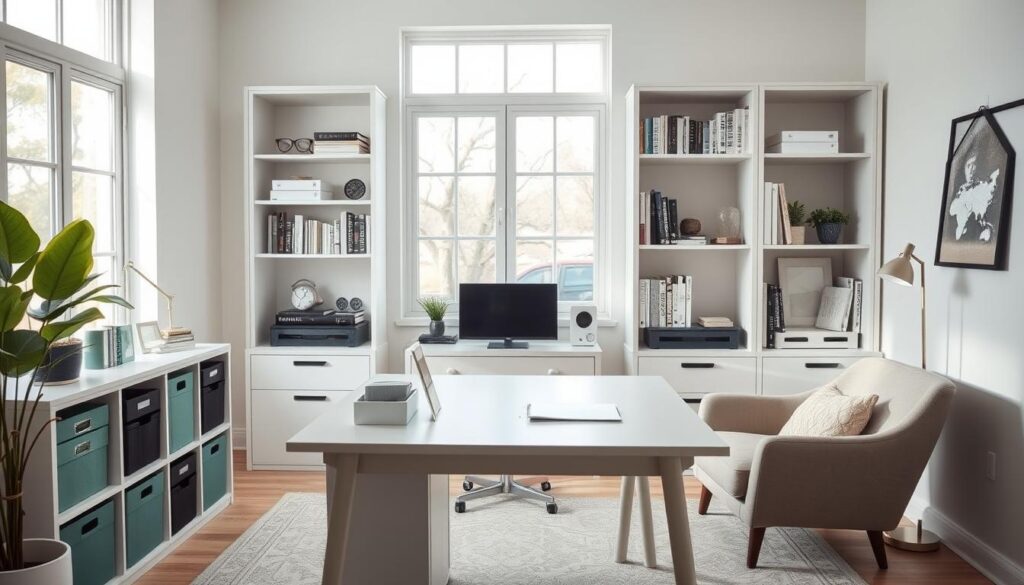
- Assess your space: Note overcrowded areas like kitchen drawers or cluttered countertops.
- Set a 30-minute timer daily to maintain momentum without burnout.
- Invest in affordable tools like stackable containers or clear bins for transparency.
Decluttering tips include labeling storage items and using vertical space with over-the-door hooks. Start with quick wins—like tidying a desk—to build confidence. Decluttering tips also stress the importance of asking: “Does this bring joy or serve a purpose?”
- Use drawer dividers for small items.
- Repurpose shoe organizers for pantry or bathroom storage.
- Store seasonal items in vacuum-seal bags to save space.
Maintain progress with routines like daily 5-minute tidy sessions. Remember: perfection isn’t the goal. Small, consistent actions create lasting order.
The KonMari Method and Other Popular Decluttering Approaches
Decluttering isn’t a one-size-fits-all solution. These proven strategies offer tailored solutions to transform spaces through intentional choices.
Marie Kondo’s Joy-Sparking Philosophy
Her method focuses on emotional connections. Hold each item and ask: Does it spark joy? If not, it’s time to let it go. Her folding techniques help maximize drawer space, fitting well with minimalist home organization goals.
The Four-Box Decluttering Method
Sort possessions into four categories: keep, donate, store, or discard. Here’s how to do it:
- Start with one room, tackling items in batches.
- Decide: If unsure, place in a “maybe” box for later review.
- Revisit the “maybe” items weekly to avoid retention bias.
The Minimalist Approach
Focus on utility over sentimentality. Follow rules like “one in, one out” to maintain balance. Ask yourself: Is this necessary? Does it serve a purpose?
| Method | Key Principle | Best For |
|---|---|---|
| KonMari | Emotional resonance | Those prioritizing joy and aesthetics |
| Four-Box | Categorization | Structured decision-making |
| Minimalist | Utility-focused reduction | Goal-driven decluttering |
Room-by-Room Decluttering Strategies
Make your home better with strategies for each room. These functional home storage and organized home hacks make every space useful and tidy.
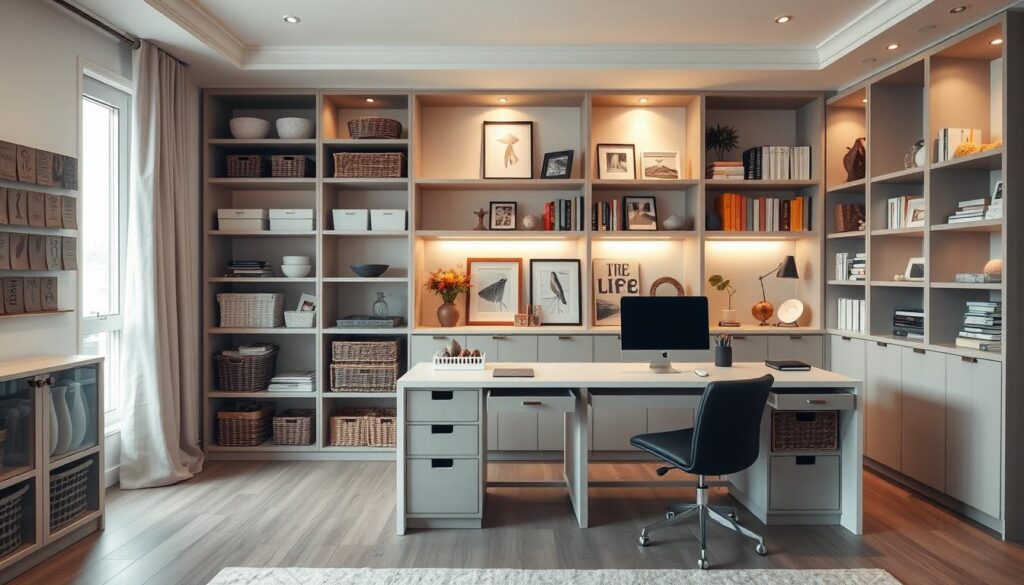
Kitchen Organization: Beyond the Junk Drawer
Make your kitchen more efficient with vertical storage for spices and pots. Use clear bins in pantries for snacks and baking supplies. Always clean up as you go: store small appliances in their places after use.
Pull-out shelves in lower cabinets make essentials easy to reach.
Bathroom Solutions: Maximizing Limited Space
Install over-the-door organizers for towels and toiletries. Under-sink racks keep cleaning supplies separate from personal items. Shower caddies and magnetic strips on mirrors save counter space.
Choose stackable containers for bath products to keep corners tidy.
Bedroom Serenity: Clutter-Free Sanctuary
Get drawer dividers for socks and underwear. Use over-bed storage for seasonal clothes. Nightstands should only hold essentials—add a tray for bedtime items.
Under-bed bins store off-season bedding, and closet systems organize clothes by type and season.
Living Room Organization: Function Meets Style
Storage benches serve as both seating and hidden storage. Floating shelves display decor while keeping shelves clear. Coffee tables with hidden compartments hide remotes and magazines.
Use modular furniture for toy storage in family rooms, blending style with function.
Smart Storage Solutions for Small Spaces
Small spaces don’t have to look or feel cramped. Use vertical storage to save floor space. Wall-mounted shelves, floating racks, and over-door hooks are great for hidden storage. Stacking containers with tight lids helps keep things tidy.
- Vertical systems: Install ladder bookcases or pegboards for tools and decor.
- Multi-tasking furniture: Ottomans with hidden storage, bed frames with drawers, and extendable dining tables save square footage.
- Hidden zones: Utilize under-stair niches, back-of-door pockets, and space above cabinets with tension rods.
Storage bags like SpaceSaver or vacuum-sealed containers shrink seasonal items. Digital tools like Google Drive replace bulky files.
“Empty walls and open corners are wasted opportunities,” says storage expert Linda Walker. “Every surface can multitask.”
Choose clear bins and simple designs to keep things looking good. Thrifty options include IKEA’s Expedit shelving or DIY hanging baskets. Even small spaces can be organized and stylish.
Technological Aids for Home Organization
Modern technology has changed how we manage our homes. Now, we have apps and devices to make our lives easier. These tools help us keep our spaces tidy and organized.
Apps to Track and Maintain Order
Apps like Notion and Todoist help us keep track of our belongings. They also let us schedule maintenance. Digital organizers, such as 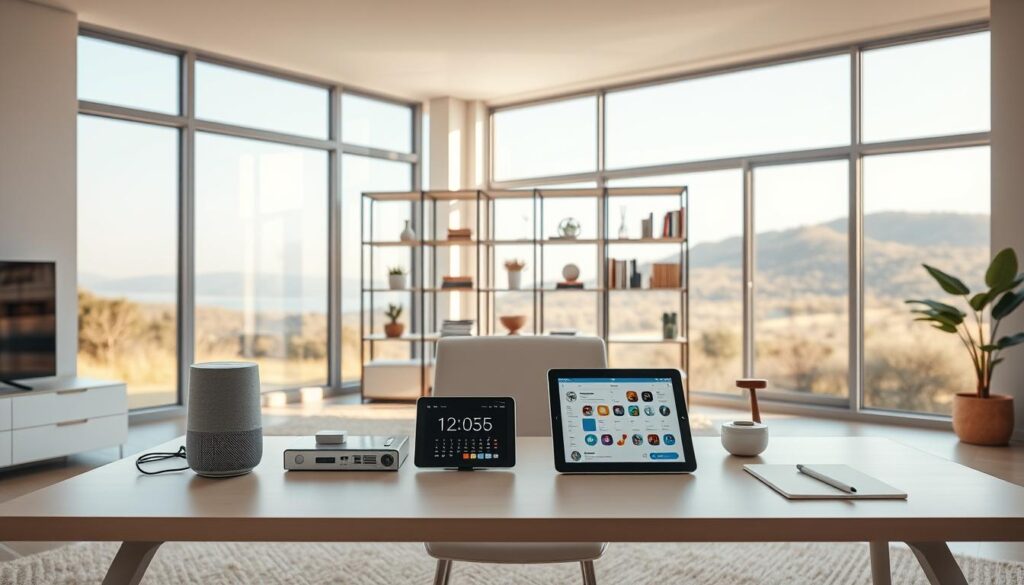
- Notion: Create customizable databases for room-by-room inventories.
- Google Drive: Digitize documents to reduce paper clutter.
- Password managers like 1Password organize digital keys securely.
Smart Home Devices That Streamline Spaces
Voice assistants like Amazon Alexa or Google Home make our lives easier. Smart shelves remind us when it’s time to restock. Robotic vacuums like iRobot Roomba save us time for more important tasks.
Digital Decluttering: Organizing Your Virtual Spaces
Feeling overwhelmed by emails? Unroll.Me can help. Cloud storage with Google Photos keeps your digital files in order. Here’s how to stay organized digitally:
- Delete redundant files monthly.
- Use folder systems for documents.
- Enable auto-backup features.
Keeping your home organized is about finding the right balance. Choose tools that make your life simpler, not more complicated.
Sustainable Decluttering: Eco-Friendly Ways to Discard Unwanted Items
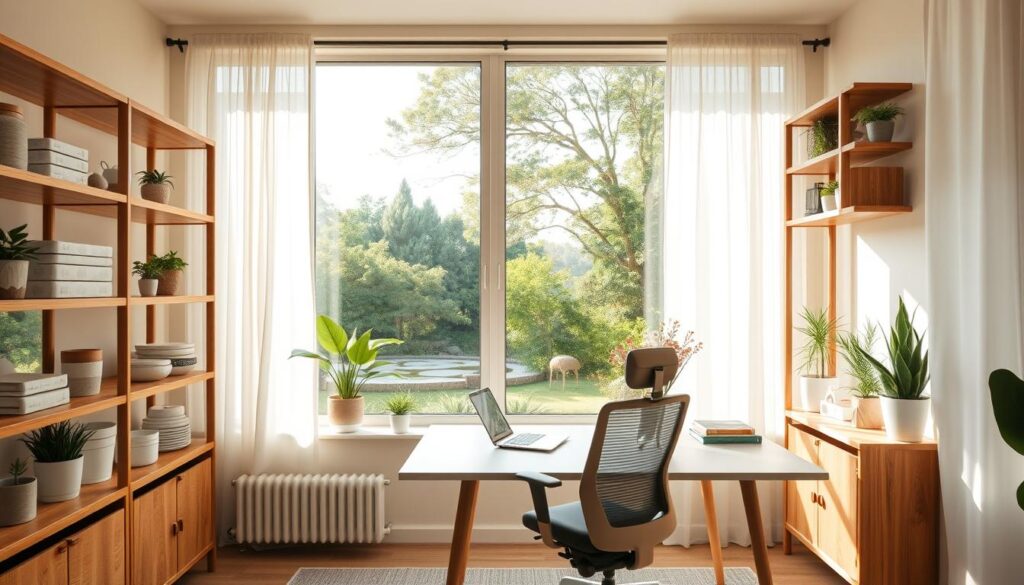
Keeping your home tidy is more than just cleaning. It’s about how you get rid of things too. Sustainable decluttering means turning unwanted items into something useful, not trash. Here’s how to make your organizing efforts green.
Donation vs. Selling: What’s Best for Your Items
Deciding between donating or selling depends on the item’s condition and value. Home organizing solutions work best when you:
- Donate gently used items to places like Goodwill or Salvation Army for tax breaks (keep receipts!)
- Sell items like electronics, furniture, or collectibles on eBay or Facebook Marketplace to make money
- Look up IRS rules for tax deductions on donations
Recycling Difficult Items
Hard-to-get-rid-of items need special handling. Here’s what to do:
- Electronics: Use Best Buy’s recycling kiosks or manufacturer programs
- Hazardous materials: Find local drop-offs for hazardous waste at Earth911’s recycling locator
- Textiles: H&M will recycle old clothes in their stores
Creating a Circular Economy in Your Home
Move away from throwaway culture and towards lasting systems:
- Choose products that can be fixed or last long (like Patagonia’s Worn Wear program)
- Join Freecycle or Nextdoor to share items with your community
- Use jars for storage or give them to community gardens
Every choice to reuse, fix, or recycle helps. Start with small steps. Your actions can make a big difference for your home and the planet.
Maintaining a Clutter-Free Home: Daily Habits and Routines
Small daily actions build lasting order. Adopt these organized home hacks to turn maintenance into effortless routines:
- One-minute rule: Tidy as you go—hang coats, return items immediately
- Drop zones: Designated spots for keys, bags, and mail near entryways
- Evening reset: Spend 5 minutes straightening high-traffic areas nightly
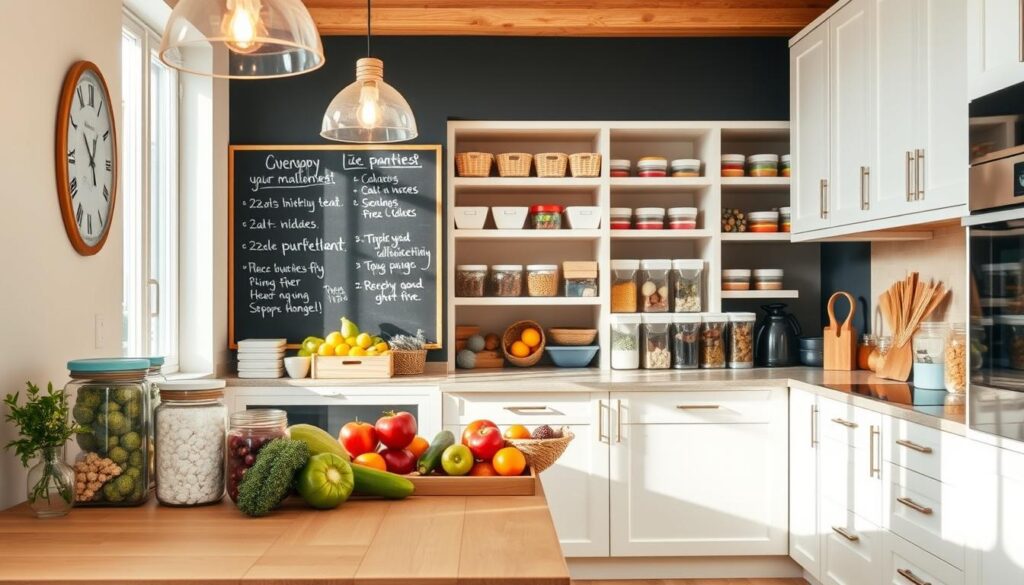
Weekly maintenance prevents backlogs. Schedule 30 minutes each Sunday for:
- Sorting mail and digital inboxes
- Inspecting storage systems for overflow
- Rotating seasonal items (e.g., holiday decor to basements)
| Season | Action |
|---|---|
| Spring | Clothing swaps: store winter gear, unpack summer wear |
| Summer | Outdoor storage audits |
| Fall | Back-to-school supplies reorganization |
| Winter | Holiday decoration prep and storage |
“Maintenance is 80% mindset,” says Decluttering Daily author Sarah MacLaughlin. “Build habits around existing routines.”
For households with children or pets, assign efficient home organization roles. Use magnetic boards for chore tracking and pet-specific storage bins. Remote workers: end each day with a “digital and physical desktop reset.”
Track progress with a 12-week habit calendar. Consistency—not perfection—keeps systems alive. A well-maintained space becomes a foundation for daily calm.
Cost-Effective Home Organizing Solutions That Make a Big Impact
Smart organizing doesn’t need a big budget. These tips show how to create functional home storage and maximizing storage space using what you have or affordable options. Start with these proven methods:
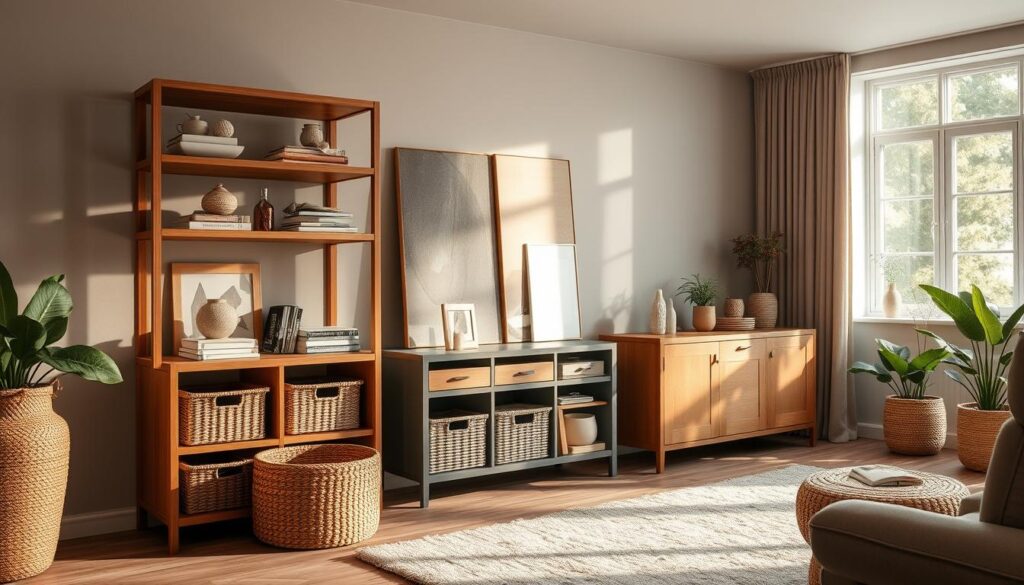
DIY Organization Projects
Turn everyday materials into storage solutions:
| Project | Materials | Cost |
|---|---|---|
| Drawer Dividers | Cardboard, glue, ruler | $3 (vs $12 store-bought) |
| Fabric Bins | Scrap fabric, ribbon, scissors | $5 (vs $15 pre-made) |
Add pegboards ($15) with hooks to free wall space. Under-shelf baskets ($3 each) hide clutter under cabinets.
Budget-Friendly Storage Solutions
Stores like Walmart and Target offer bins from $2–$8. Thrift stores sell shelves for $10. Restaurant supply stores sell stackable containers for $3–$5, ideal for pantries. Look for sales days at IKEA for discounted bins.
Repurposing Existing Items
Turn old items into organizers:
- Magazine files → wrap storage
- Tension rods → cleaning tool racks
- Shower hooks → scarf organizers
- Shoe organizers (mounted vertically) → craft supply storage
Repurposing maximizing storage space while saving money. A $2 shower rod works as a closet rod for belts or bags.
Conclusion: Transforming Your Space and Life Through Thoughtful Organization
Decluttering is more than just cleaning. It’s a way to live more intentionally. By using smart decluttering strategies, like Marie Kondo’s method, you make your space reflect your values. This approach reduces stress and gives you more time for important things.
Every step toward order helps your well-being. You can use organized home hacks or digital tools to achieve this. These methods help you create a space that supports your happiness.
There’s no single way to declutter. It might start with a messy drawer or a cluttered closet. Small, regular efforts, like tidying for 10 minutes a day, can lead to big changes. Focus on areas that bother you the most, like messy entryways or piles of papers.
It’s also important to be sustainable. Donate, recycle, or repurpose items to reduce waste. This way, you help the environment while organizing your space.
Technology and affordable solutions make it easy for everyone. Apps like AnyList and smart storage from The Container Store can help. Remember, organization is a journey, not a destination. Let your space grow with you.
By aligning your home with your values, you create a space that boosts productivity and relaxation. It’s not about being perfect. It’s about having a space that truly supports you. Start with a small step today, and see how your home and mind can change.




